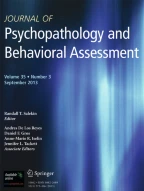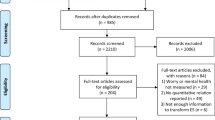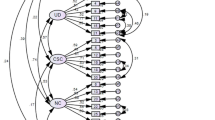Psychometric Properties of the Penn State Worry Questionnaire-Past Week (PSWQ-PW) in an Anxiety and Related Disorders Sample

Worry is a transdiagnostic characteristic across many mental health disorders and given the increased interest and recognized importance of measurement-based care and progress monitoring for mental health treatment, there is a need for psychometrically sound questionnaires that can track weekly progress. The Penn State Worry Questionnaire-Past Week (PSWQ-PW; Stöber & Bittencourt Behaviour Research and Therapy, 36(6), 645–656, 1998) was developed to be sensitive to the assessment of short-term changes in worry severity. This study examined the psychometric properties and treatment sensitivity of the PSWQ-PW in a sample of 370 outpatients with anxiety and related disorders. An exploratory factor analysis indicated that the PSWQ-PW has a one-factor structure measuring the unidimensional construct of worry. The PSWQ-PW demonstrated strong reliability and good convergent validity. However, the PSWQ-PW had poor discriminant validity with a measure of depression and stress, which may be explained by the distinct but related nature of these constructs. Additionally, the PSWQ-PW did not have strong diagnostic potential in identifying individuals with Generalized Anxiety Disorder (GAD) from a heterogeneous clinical sample, likely because of the transdiagnostic nature of worry and the state nature of the measure. Finally, the PSWQ-PW demonstrated strong treatment sensitivity (d = 0.85) when measured weekly across a 12-week cognitive behavioural therapy for GAD protocol. These findings suggest that the PSWQ-PW is a reliable and valid way to track changes in worry severity week-to-week to monitor patient progress throughout treatment. However, it should not be used as a diagnostic or screening measure to distinguish patients with GAD from those with other anxiety and related disorders.
This is a preview of subscription content, log in via an institution to check access.
Access this article
Subscribe and save
Springer+ Basic
€32.70 /Month
- Get 10 units per month
- Download Article/Chapter or eBook
- 1 Unit = 1 Article or 1 Chapter
- Cancel anytime
Buy Now
Price includes VAT (France)
Instant access to the full article PDF.
Rent this article via DeepDyve
Similar content being viewed by others

The Relation Between Worry and Mental Health in Nonclinical Population and Individuals with Anxiety and Depressive Disorders: A Meta-Analysis
Article 07 January 2022

The Penn State Worry Questionnaire for Children: Age, Gender and Clinical Invariance
Article 22 June 2016

Psychometric Evaluation of the Metacognitions Questionnaire – Short Form (MCQ-30) in Generalized Anxiety Disorder: Reliability, Validity and Utility in a Clinical Sample
Article Open access 25 May 2024
Data Availability
The datasets and materials utilized and/or analyzed during the current study are available from the corresponding author on reasonable request.
Code Availability
Notes
This analysis was reconducted to determine if the pattern of the results would differ based on assessment format. For those diagnosed with the DART (n = 177), we compared scores of the PSWQ-PW in those with a clinical diagnosis of GAD (n = 126) with those who did not (n = 51). The result was not statistically significant (t(175) = -1.01, p = .213, d = − 0.08), indicating that the PSWQ-PW scores were not different between those with GAD and those who did not have GAD. The mean for the GAD group was 64.46 (SD = 12.94) whereas the mean was 63.95 (SD = 12.62) for those without a diagnosis of GAD. For those who received a psychiatric consult to determine diagnosis (n = 193), we compared scores of the PSWQ-PW in those with a clinical diagnosis of GAD (n = 120) with those who did not (n = 73). The result was not statistically significant (t(191) = -1.14, p = .258, d = − 0.08), indicating that the PSWQ-PW scores were not different between those with GAD and those who did not have GAD. The mean for the GAD group was 67.03 (SD = 14.18) whereas the mean was 64.47 (SD = 15.78) for those without a diagnosis of GAD.
This analysis was reconducted to determine if the pattern of the results would differ based on assessment format. When the ROC analysis was conducted with those diagnosed with the DART (n = 177), the area under the curve was 0.544 (SE = 0.047, 95% CI: 0.451, 0.637), indicating that the PSWQ-PW did not have strong diagnostic potential in a heterogeneous clinical sample of individuals with varying anxiety and related disorders. When the ROC analysis was conducted with those who received a psychiatric consult to determine diagnosis (n = 193), the area under the curve was 0.536 (SE = 0.043, 95% CI: 0.452, 0.620), indicating that the PSWQ-PW did not have strong diagnostic potential in a heterogeneous clinical sample of individuals with varying anxiety and related disorders.
References
- American Psychiatric Association. (2013). Diagnostic and statistical manual of mental disorders (5th ed.). https://doi.org/10.1176/appi.books.9780890425596
- Antony, M. M., Bieling, P. J., Cox, B. J., Enns, M. W., & Swinson, R. P. (1998). Psychometric properties of the 42-item and 21-item versions of the Depression anxiety stress Scales in clinical groups and a community sample. Psychological Assessment,10(2), 176–181. https://doi.org/10.1037/1040-3590.10.2.176ArticleGoogle Scholar
- Beck, J. G., Stanley, M. A., & Zebb, B. J. (1995). Psychometric properties of the Penn state worry questionnaire in older adults. Journal of Clinical Geropsychology,1(1), 33–42. Google Scholar
- Behar, E., Alcaine, O., Zuellig, A. R., & Borkovec, T. D. (2003). Screening for generalized anxiety disorder using the Penn state worry questionnaire: a receiver operating characteristic analysis. Journal of Behavior Therapy and Experimental Psychiatry,34(1), 25–43. https://doi.org/10.1016/S0005-7916(03)00004-1ArticlePubMedGoogle Scholar
- Berle, D., Starcevic, V., Moses, K., Hannan, A., Milicevic, D., & Sammut, P. (2011). Preliminary validation of an ultra-brief version of the Penn state worry questionnaire. Clinical Psychology & Psychotherapy,18(4), 339–346. https://doi.org/10.1002/cpp.724ArticleGoogle Scholar
- Borkovec, T. D., & Costello, E. (1993). Efficacy of applied relaxation and cognitive-behavioral therapy in the treatment of generalized anxiety disorder. Journal of Consulting and Clinical Psychology,61(4), 611–619. https://doi.org/10.1037/0022-006X.61.4.611ArticlePubMedGoogle Scholar
- Borkovec, T. D., Shadick, R. N., & Hopkins, M. (1991). The nature of normal and pathological worry. In R. M. Rapee & D. H. Barlow (Eds.), Chronic anxiety: generalized anxiety disorder and mixed anxiety-depression (pp. 29–51). Guilford Press. Google Scholar
- Brown, T. A. (2003). Confirmatory factor analysis of the Penn state worry questionnaire: multiple factors or method effects? Behaviour Research and Therapy,41(12), 1411–1426. https://doi.org/10.1016/S0005-7967(03)00059-7ArticlePubMedGoogle Scholar
- Brown, T. A., Antony, M. M., & Barlow, D. H. (1992). Psychometric properties of the Penn state worry questionnaire in a clinical anxiety disorders sample. Behaviour Research and Therapy,30(1), 33–37. https://doi.org/10.1016/0005-7967(92)90093-VArticlePubMedGoogle Scholar
- Buck, J. M., Kelly, W. E., & Silver, N. C. (2008). An investigation of the relationship between depression and worry: a research note. Individual Differences Research,6(2), 120–122. Google Scholar
- Chelminski, I., & Zimmerman, M. (2003). Pathological worry in depressed and anxious patients. Journal of Anxiety Disorders,17(5), 533–546. https://doi.org/10.1016/S0887-6185(02)00246-3ArticlePubMedGoogle Scholar
- Clark, D. M., Canvin, L., Green, J., Layard, R., Pilling, S., & Janecka, M. (2018). Transparency about the outcomes of mental health services (IAPT approach): an analysis of public data. The Lancet,391(10121), 679–686. https://doi.org/10.1016/S0140-6736(17)32133-5ArticleGoogle Scholar
- Deschênes, S. S., & Dugas, M. J. (2013). Sudden gains in the cognitive-behavioral treatment of generalized anxiety disorder. Cognitive Therapy and Research,37(4), 805–811. https://doi.org/10.1007/s10608-012-9504-1ArticleGoogle Scholar
- Derogatis, L. (1994). SCL–90–R: Symptom Checklist-90–R. Administration, scoring, and procedural manual. National Computer Systems. Google Scholar
- Fresco, D. M., Heimberg, R. G., Mennin, D. S., & Turk, C. L. (2002). Confirmatory factor analysis of the Penn state worry questionnaire. Behaviour Research and Therapy,40(3), 313–323. https://doi.org/10.1016/S0005-7967(00)00113-3ArticlePubMedGoogle Scholar
- Fresco, D. M., Mennin, D. S., Heimberg, R. G., & Turk, C. L. (2003). Using the Penn state worry questionnaire to identify individuals with generalized anxiety disorder: a receiver operating characteristic analysis. Journal of Behavior Therapy and Experimental Psychiatry,34(3–4), 283–291. https://doi.org/10.1016/j.jbtep.2003.09.001ArticlePubMedGoogle Scholar
- Glorfeld, L. W. (1995). An improvement on Horn’s parallel analysis methodology for selecting the correct number of factors to retain. Educational and Psychological Measurement,55(3), 377–393. ArticleGoogle Scholar
- Goodman, J. D., McKay, J. R., & DePhilippis, D. (2013). Progress monitoring in mental health and addiction treatment: a means of improving care. Professional Psychology: Research and Practice,44(4), 231–246. https://doi.org/10.1037/a0032605ArticleGoogle Scholar
- Hazlett-Stevens, H., Ullman, J. B., & Craske, M. G. (2004). Factor structure of the Penn state worry questionnaire: examination of a method factor. Assessment,11(4), 361–370. ArticlePubMedGoogle Scholar
- Henry, J. D., & Crawford, J. R. (2005). The 21-item version of the depression anxiety stress scales (DASS–21): normative data and psychometric evaluation in a large non-clinical sample. The British Journal of Clinical Psychology,44(22), 227–239. https://doi.org/10.1348/014466505X29657ArticlePubMedGoogle Scholar
- Hopko, D. R., Reas, D. L., Beck, J. G., Stanley, M. A., Wetherell, J. L., Novy, D. M., & Averill, P. M. (2003). Assessing worry in older adults: confirmatory factor analysis of the Penn state worry questionnaire and psychometric properties of an abbreviated model. Psychological Assessment,15(2), 173–183. https://doi.org/10.1037/1040-3590.15.2.173ArticlePubMedGoogle Scholar
- Lambert, M. J., Whipple, J. L., & Kleinstäuber, M. (2018). Collecting and delivering progress feedback: a meta-analysis of routine outcome monitoring. Psychotherapy,55(4), 520–537. https://doi.org/10.1037/pst0000167ArticlePubMedGoogle Scholar
- Lovibond, P. F., & Lovibond, S. H. (1995). The structure of negative emotional states: comparison of the Depression anxiety stress scales (DASS) with the Beck Depression and anxiety inventories. Behaviour Research and Therapy,33(3), 335–343. https://doi.org/10.1016/0005-7967(94)00075-UArticlePubMedGoogle Scholar
- McCabe, R. E., Milosevic, I., Rowa, K., Shnaider, P., Key, B., & Antony, M. M. (2017). Diagnostic Assessment Research Tool (DART). St. Joseph’s Healthcare/McMaster University. Google Scholar
- Meyer, T. J., Miller, M. L., Metzger, R. L., & Borkovec, T. D. (1990). Development and validation of the Penn state worry questionnaire. Behaviour Research and Therapy,28(6), 487–495. https://doi.org/10.1016/0005-7967(90)90135-6ArticlePubMedGoogle Scholar
- Moldovan, R., & Pintea, S. (2015). Mechanisms of change in psychotherapy: methodological and statistical considerations. Cognition Brain Behavior: An Interdisciplinary Journal,19(4), 299–311. Google Scholar
- Molina, S., & Borkovec, T. D. (1994). The Penn state worry questionnaire: psychometric properties and associated characteristics. In G. C. L. Davey & F. Tallis (Eds.), Worrying: perspectives on theory, assessment and treatment (pp. 265–283). Wiley. Google Scholar
- Norman, G., & Streiner, D. (2008). Principal components and factor analysis. Biostatistics: the bare essentials (pp. 208–225). BC Decker Inc. Google Scholar
- O’Connor, B. P. (2000). SPSS and SAS programs for determining the number of components using parallel analysis and Velicer’s MAP test. Behavior Research Methods Instruments & Computers,32(3), 396–402. https://doi.org/10.3758/bf03200807ArticleGoogle Scholar
- Olatunji, B. O., Wolitzky-Taylor, K. B., Sawchuk, C. N., & Ciesielski, B. G. (2010). Worry and the anxiety disorders: a meta-analytic synthesis of specificity to GAD. Applied and Preventive Psychology,14(1–4), 1–24. https://doi.org/10.1016/j.appsy.2011.03.001ArticleGoogle Scholar
- Raudenbush, S. W., & Bryk, A. S. (2002). Hierarchical linear models: applications and data analysis methods (2nd ed.). Sage Publications Inc. Google Scholar
- Schneider, L. H., Pawluk, E. J., Milosevic, I., Shnaider, P., Rowa, K., Antony, M. M., Musielak, N., & McCabe, R. E. (2022). The Diagnostic Assessment Research Tool in action: a preliminary evaluation of a semistructured diagnostic interview for DSM-5 disorders. Psychological Assessment,34(1), 21–29. https://doi.org/10.1037/pas0001059ArticlePubMedGoogle Scholar
- Scott, K., & Lewis, C. C. (2015). Using measurement-based care to enhance any treatment. Cognitive and Behavioral Practice,22(1), 49–59. https://doi.org/10.1016/j.cbpra.2014.01.010ArticlePubMedPubMed CentralGoogle Scholar
- Spitzer, R. L., Kroenke, K., Williams, J. B., & Löwe, B. (2006). A brief measure for assessing generalized anxiety disorder: the GAD-7. Archives of Internal Medicine,166(10), 1092–1097. https://doi.org/10.1001/archinte.166.10.1092ArticlePubMedGoogle Scholar
- Stöber, J. (1995). Worrying: a comparison of three questionnaires concerning everyday worries. Zeitschrift fuer Differentielle und Diagnostische Psychologie,16(1), 50–63. Google Scholar
- Stöber, J., & Bittencourt, J. (1998). Weekly assessment of worry: an adaptation of the Penn state worry questionnaire for monitoring changes during treatment. Behaviour Research and Therapy,36(6), 645–656. https://doi.org/10.1016/S0005-7967(98)00031-XArticlePubMedGoogle Scholar
- Tasca, G. A., Angus, L., Bonli, R., Drapeau, M., Fitzpatrick, M., Hunsley, J., & Knoll, M. (2019). Outcome and progress monitoring in psychotherapy: report of a canadian Psychological Association Task Force. Canadian Psychology/Psychologie Canadienne,60(3), 165–177. https://doi.org/10.1037/cap0000181ArticleGoogle Scholar
- Velicer, W. F. (1976). Determining the number of components from the matrix of partial correlations. Psychometrika,41(3), 321–327. https://doi.org/10.1007/BF02293557ArticleGoogle Scholar
- Waldrop, J., & McGuinness, T. M. (2017). Measurement-based care in psychiatry. Journal of Psychosocial Nursing and Mental Health Services,55(11), 30–35. https://doi.org/10.3928/02793695-20170818-01ArticlePubMedGoogle Scholar
Author information
Authors and Affiliations
- Department of Psychology, Neuroscience & Behaviour, McMaster University, Hamilton, Ontario, Canada Christina Puccinelli & Mélise J. Ouellette
- Anxiety Treatment and Research Clinic, St. Joseph’s Healthcare Hamilton, 100 West 5th Street, Hamilton, ON, L9C 0E3, Canada Christina Puccinelli, Duncan H. Cameron, Mélise J. Ouellette, Randi E. McCabe & Karen Rowa
- Department of Psychiatry and Behavioural Neurosciences, McMaster University, Hamilton, Ontario, Canada Randi E. McCabe & Karen Rowa
- Christina Puccinelli




